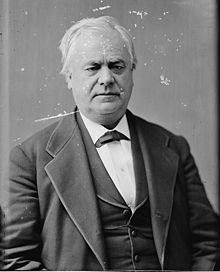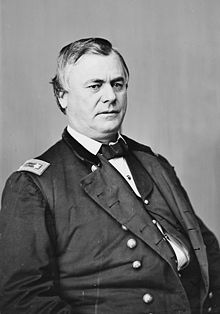Richard J. Oglesby
This article includes a list of general references, but it lacks sufficient corresponding inline citations. (October 2021) |
Richard J. Oglesby | |
|---|---|
 c. 1875 | |
| 14th Governor of Illinois | |
| In office January 16, 1865 – January 11, 1869 | |
| Lieutenant | William Bross |
| Preceded by | Richard Yates |
| Succeeded by | John M. Palmer |
| In office January 13, 1873 – January 23, 1873 | |
| Lieutenant | John Lourie Beveridge |
| Preceded by | John M. Palmer |
| Succeeded by | John Lourie Beveridge |
| In office January 30, 1885 – January 14, 1889 | |
| Lieutenant | John Smith |
| Preceded by | John Marshall Hamilton |
| Succeeded by | Joseph W. Fifer |
| United States Senator from Illinois | |
| In office March 4, 1873 – March 3, 1879 | |
| Preceded by | Lyman Trumbull |
| Succeeded by | John A. Logan |
| Member of the Illinois Senate | |
| In office 1860 | |
| Personal details | |
| Born | Richard James Oglesby July 25, 1824 Oldham County, Kentucky |
| Died | April 24, 1899 (aged 74) Elkhart, Illinois |
| Political party | Republican |
| Alma mater | University of Louisville |
| Signature | |
| Military service | |
| Allegiance | United States |
| Branch/service | United States Army Union Army |
| Years of service | 1846–1847 1861–1864 |
| Rank | |
| Battles/wars | Mexican–American War, American Civil War |
Richard James Oglesby (July 25, 1824 – April 24, 1899) was an American soldier and Republican politician from Illinois, who served three non-consecutive terms as Governor of Illinois (from 1865 to 1869, for ten days in 1873, and from 1885 to 1889) and as a United States Senator from Illinois (from 1873 to 1879), and earlier was a member of the Illinois Senate, elected in 1860. The town of Oglesby, Illinois, is named in his honor,[1] as is an elementary school situated in the Auburn Gresham neighborhood of Chicago's south side.[2][3]
He served in the United States Army during the Mexican–American War of 1846–47, and after the war became a prospector during the California Gold Rush and was elected to the Illinois General Assembly. During the American Civil War, Oglesby volunteered for the Union Army and rose to the rank of major general, serving in the Western Theater; he left the army when he was elected Governor of Illinois in 1864.
Early years
[edit]Oglesby was born in Floydsburg, Oldham County, Kentucky.[4] He was orphaned and moved to live with his uncle in Decatur, Illinois in 1836, where he worked as a farmhand and carpenter.[5]
Mexican–American War
[edit]With the outbreak of the Mexican–American War, he enlisted as a 1st Lieutenant in Company C, 4th Illinois Volunteer Infantry Regiment [6] taking part in the battles of Veracruz and Cerro Gordo "where his regiment almost captured Mexican President General Santa Anna, but they had to settle for his cork leg, carriage and $20,000 in gold".[7]
He might have participated in what may have been the first baseball game ever played outside the U.S., at the end of April 1847, a few days after the Battle of Cerro Gordo, "with the wooden leg captured (by the Fourth Illinois regiment) from General Santa Anna".[8]
He was mustered out of the volunteer service in May 1847.[citation needed]
Entry into politics
[edit]He studied at Louisville Law School in 1848, but traveled to California for the gold rush in 1849, where he tried his hand at gold mining. After two years of traveling in Europe, he returned to Illinois in 1851[9] and joined the Republican Party at its formation. Oglesby ran unsuccessfully for the U.S. Congress in 1858 but was elected to the Illinois Senate in 1860. In 1859, Oglesby married Decatur native Anna White. They had four children: Richard, Elizabeth, Robert, and Olive.[citation needed] Oglesby was one of the earliest advocates for Abraham Lincoln's nomination as the 1860 presidential candidate of the Republican Party; it may have been he who applied the moniker "Railsplitter" to Lincoln.
Civil War
[edit]
At the start of the Civil War, Oglesby was appointed colonel of the 8th Illinois Volunteer Infantry Regiment. He was a well-liked commander, receiving the moniker "Uncle Dick" from his troops. He commanded his brigade at the battles of Fort Henry and Fort Donelson and soon after was promoted to the rank of brigadier general. He commanded troops during the Siege of Corinth. Oglesby sustained severe injuries in the Battle of Corinth in 1862 and was elevated to the status of major general that same year.[10]
After a brief period of recovery, Oglesby resumed military service in 1863. However, at the request of Abraham Lincoln, he abandoned his commission in 1864, successfully running for Illinois governor on the Republican ticket.[10]
He was present in the room at the Petersen House when President Abraham Lincoln died on April 15, 1865.[11]
Illinois politics
[edit]
Oglesby first served as governor of Illinois from 1865 to 1869. During his tenure as governor, he advocated improving the quality of care of the mentally ill and for other groups of disabled citizens. He also signed legislation expanding the State Hospital system from one campus to three.[12] After his term ended, he practiced law until 1872, when he agreed to a scheme in which Oglesby ran again for governor, but turned the office over to the lieutenant governor immediately after inauguration in return for a seat in the U.S. Senate. He served as a Senator from 1873 until 1879. In 1884, he was reelected governor for a third time, becoming the first man in Illinois history to serve three times as governor. At the end of his third term as governor, he tried unsuccessfully to be reelected to his Senate seat. He spent his remaining years in retirement and died at his "Oglehurst" estate in Elkhart, Illinois. He is buried there in Elkhart Cemetery. There is a statue of Richard J. Oglesby in Lincoln Park, Chicago.
His son, John G. Oglesby, was a two time Lieutenant Governor of Illinois.
See also
[edit]Notes
[edit]- ^ "History of Oglesby, Illinois". City of Oglesby. Archived from the original on May 18, 2022. Retrieved May 18, 2022.
- ^ "Richard J. Oglesby Elementary". Richard J. Oglesby Elementary. Chicago Public Schools. Retrieved April 20, 2022.
- ^ "Oglesby Elementary School". Oglesby Elementary School. Google Maps. Retrieved April 20, 2022.
- ^ "Richard J. Oglesby". Portrait and Biographical Album of Champaign County, Illinois. Chapman Brothers, Chicago, 1887. Retrieved June 23, 2011.
- ^ "Governor Oglesby and Family". Oglesby Mansion. Retrieved May 18, 2022.
- ^ Lincoln's Rail-Splitter by Mark Plummer 2001
- ^ "The Oglesby Mansion in Decatur, Illinois". Archived from the original on October 19, 2014. Retrieved February 21, 2011.
- ^ Terry's Guide to Mexico, 1909, page=506, repeated in following editions thru at least 1947
- ^ Eicher, p. 408.
- ^ a b "Richard James Oglesby". American Battlefield Trust. Retrieved May 18, 2022.
- ^ "Abraham Lincoln in Illinois". www.ilsos.gov. Retrieved May 18, 2022.
- ^ Briska, William (1997). The History of Elgin Mental Health Center: Evolution of a State Hospital. Crossroads Communications. p. 12. ISBN 0-916445-45-3.
References
[edit]- Eicher, John H., and David J. Eicher. Civil War High Commands. Stanford, CA: Stanford University Press, 2001. ISBN 0-8047-3641-3.
- Warner, Ezra J. Generals in Blue: Lives of the Union Commanders. Baton Rouge: Louisiana State University Press, 1964. ISBN 0-8071-0822-7.
Further reading
[edit]- Plummer, Mark A. Lincoln's Rail Splitter: Governor Richard J. Oglesby. Urbana: University of Illinois Press, 2001. ISBN 0-252-02649-7.
- Townsend, George Alfred. The Life, Crime and Capture of John Wilkes Booth. New York: Dick & Fitzgerald, 1865. OCLC 8110858.
External links
[edit]- 1824 births
- 1899 deaths
- American people of Scottish descent
- Republican Party Illinois state senators
- Republican Party governors of Illinois
- People from Decatur, Illinois
- People from Elkhart, Illinois
- People from Oldham County, Kentucky
- People of Illinois in the American Civil War
- Republican Party United States senators from Illinois
- Union army generals
- People of the California Gold Rush
- Union (American Civil War) state governors
- 19th-century American politicians


